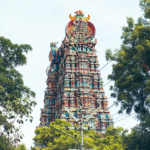
Sri Lanka, an island nation in the Indian Ocean, boasts a rich tapestry of history that spans over two millennia. From ancient kingdoms and sacred temples to colonial forts and monastic caves, the country offers a plethora of heritage sites that attract history enthusiasts. These sites not only showcase architectural brilliance but also narrate tales of dynasties, religions, and cultures that have shaped the nation’s identity. For history buffs, exploring Sri Lanka is akin to travelling to a living museum. Each monument and ruins stand as a testament to the island’s diverse past, reflecting influences from Buddhism, Hinduism, Islam, and Christianity, as well as colonial imprints from the Portuguese, Dutch, and British. The Sri Lanka UNESCO heritage sites offer immersive experiences that transport visitors back in time. In this blog, we, Memorable India, will take you on a tour of some heritage sites in Sri Lanka, each holding a unique place in the annals of history. Continue reading
These destinations are not just tourist attractions, they are chronicles etched in stone, wood, and earth waiting to be explored and appreciated by those who have passion for the past.
Sigiriya, often referred to as the “Eight Wonder of the World,” is a 5th-century rock fortress located in central Sri Lanka. Rising 180m above the surrounding plains, this monolithic rock was transformed into a royal citadel by King Kashyapa between 477 and 495 CE. This site is renowned for its advanced urban planning, sophisticated water gardens, and exquisite frescoes. The ascent to the summit begins with a walk through symmetrical gardens and pools showcasing ancient hydraulic engineering marvels. Halfway up, visitors encounter the famous ‘Mirror Wall’ once so polished that the king could see his reflection. Adjacent to it are frescoes of celestial medians painted with natural pigments that have withstood the test of time. The most iconic feature is the massive Lion’s Paws carved into the rock, which once formed the entrance to the palace. At the summit, the ruins of the royal palace offer a panoramic view of the surrounding countryside. Sigiriya’s blend of natural beauty and human ingenuity has earned it UNESCO World Heritage statues, making it one of the must-visit historical places in Sri Lanka for history enthusiasts.
Timings: 7:00 AM to 5:30 PM
Entry Fee:
Note: 1200 steep steps need to climb the summit.
Located in the heart of Kandy, the Temple of the Sacred Tooth Relic, or Sri Dalada Maligawa, is one of the most revered Buddhist sites in Sri Lanka. The temple houses the tooth relic of Gautama Buddha, making it a significant pilgrimage site for Buddhists worldwide. The temple complex, part of the royal palace, showcases traditional Kandyan architecture with its golden roof shrine and intricate wood carvings. The relics are enshrined in a gold casket and are displayed to devotees during special ceremonies. The annual Esala Perahera, a grand procession featuring dancers, drummers, and decorated elephants, celebrates the relic and attracts thousands of visitors. Beyond its religious significance, the temple plays a pivotal role in Sri Lanka’s political history, symbolizing the legitimacy of the ruling monarch. Recognized as a UNESCO World Heritage site, the Temple of the Sacred Tooth Relic offers a profound insight into the island’s spiritual and cultural heritage.
Timings: 5:30 AM to 8:00 PM
Entry Fee: LKR 1500 (Foreigners), LKR 750 (Indian)
Entry is free for Sri Lankan locals
The Dambulla Cave Temple, also known as the ‘the Golden Temple of Dambulla,’ is the largest and best-preserved cave temple complex in Sri Lanka. Located in the central part of the country, this UNESCO World Heritage site has been a sacred pilgrimage site for over 22 centuries. This one of the ancient sites in Sri Lanka has a complex comprising five caves adorned with over 150 statues of Lord Buddha and intricate murals covering an area of 2100 sq.m. These artworks depict scenes from Bhuddha’s life, as well as significant events in Sri Lankan history.
The caves carved into 160m high rock offer panoramic views of the surrounding plains. The temple’s origins date back to the 1st century BC when King Valagamba sought refuge in the caves during the period of exile. Upon regaining his throne, he transformed the caves into a magnificent temple complex. The site’s continuous use and preservation over the millennium make it a testament to Sri Lanka’s enduring Buddhist traditions.
Timings: 7:00 AM to 7:00 PM
Entry Fee: LKR 2000 (Foreigners), LKR 100 (Locals)
Anuradhapura, one of the ancient capitals of Sri Lanka, was a center of Theravada Buddhism for centuries. Founded in the 4th century BCE, it flourished for over a millennium, becoming a hub of political and religious activity. Today, the city is a UNESCO World Heritage Site, renowned for its well-preserved ruins and sacred sites. Key attractions include the Sri Maha Bodhi, a sacred fig tree grown from a cutting of the original Bodhi tree under which Buddha attained enlightenment.
The city also boasts massive stupas like Ruwanwelisaya and Jetavanaramaya, ancient monasteries, and intricate stone carvings. These structures reflect the architectural and engineering prowess of ancient Sri Lankan civilization. Anuradhapura’s extensive archaeological sites offer a glimpse into the island’s rich history, making it one of the best Sri Lanka history tour destinations for history enthusiasts and spiritual seekers alike.
Timings: 7:00 AM to 5:00 PM
Entry Fee: 15 USD (Foreigners), LKR 100 (Local Adults), LKR 50 (Local Children)
Situated on the southwestern coast, Galle Fort is a fortified city that reflects the colonial history of Sri Lanka. Initially built by the Portuguese in the late 16th century, it was extensively fortified by the Dutch during the 17th century. Today, it stands as a UNESCO world heritage site that showcases a blend of European architecture and South Asian traditions. The fort encompasses a network of streets lined with buildings from the colonial era, churches, mosques, and museums.
Notable landmarks include the Dutch Reformed Church, The Galle Lighthouse, and the Galle National Museum. The fort’s ramparts offer scenic views of the Indian Ocean and have withstood natural calamities, including the 2004 tsunami. Galle Fort is not just among historical places in Sri Lanka; it is a living city with a vibrant community, boutique hotels, cafes, and art galleries. Its well-preserved structures and rich history make it an attractive destination for those interested in colonial architecture and medieval time heritage.
Timings: Open 24 hours
Entry Fee: No Entry Charges
Polonnaruwa, the second most ancient of Sri Lanka’s kingdoms, served as a capital during the 11th and 12th centuries. After the decline of Anuradhapura, King Vijayabahu I established Polonnaruwa as a stronghold against South Indian invasions. Later, under King Parakramabahu I, the city flourished into a marvel of urban planning, irrigation and religious architecture. Today, Polonnaruwa is a UNESCO world heritage site that offers a rare glimpse into medieval Sri Lankan civilization. The city’s archeological park is scattered with ruins of royal palaces, stupas, temples, and vast reservoirs like the Parakrama Samudra and an artificial lake that still supports local agriculture.
One of the most iconic features is the Gal Vihara, a rock temple with four massive Buddha statues carved out of granite, each depicting a different pose: standing, reclining, and seated. Other highlights include the royal palace complex, the Quadrangle with its intricate moonstones and guard stones, and a Shivalaya, which reflects Hindu influence during the Chola rule. Exploring Polonnaruwa is like walking through a well-preserved open-air museum where each structure tells the story of a sophisticated, spiritually rich society. For any history buff, it is an unforgettable journey into Sri Lanka’s golden age of culture.
Timings: 7:30 AM to 6:00 PM
Entry Fee: LKR 4600 (Foreigners), LKR 2300 (SAARC Nations), Free for locals.
Nestled deep within a forested mountain range, Ritigala is a mysterious and serene archaeological site located northeast of Dambulla. Unlike other bustling heritage sites, Ritigala is cloaked in mist and myth. It was once a secluded monastery for ascetic Buddhist monks and is now known for its unique architectural layout and tranquil atmosphere. Dating back to the 1st century BCE, Ritigala served as a retreat for the Pamsukulika monks, a strict sect who shunned worldly pleasures. The ruins include stone-paved paths, meditation platforms, bathing tanks, and staircases, all seamlessly integrated into the natural landscape. The lack of any images or statues of the Buddha is intentional, reflecting the ascetic nature of the monks who once lived here. The entire mountain range is considered sacred, with legends suggesting that part of the Himalayas, brought by Hanuman in the Ramayana, fell here.
Whether myth or reality, Ritigala exudes a mystical aura that sets it apart from other heritage sites. For history buffs seeking a deeper, more reflective encounter with the past, Ritigala offers an experience rooted in simplicity, silence, and spiritual discipline. It is a hidden treasure that rewards those willing to veer off the typical tourist path.
Timings: 6:00 AM to 6:00 PM
Entry Fee: LKR 300 per person
Mihintale is regarded as the birthplace of Buddhism in Sri Lanka. Located 12 km east of Anuradhapura, this mountain peak is where Mahinda, the son of the Indian Emperor Ashoka, met King Devanampiyatissa in 2047 BC and introduced Buddhism to the island. This cultural heritage of Sri Lanka is deeply spiritual and historically significant. The climb to the summit involves over 1800 stone steps that lead to various sacred locations, including the Ambasthala Dagoba, The Aradhana Gala, and Mahindra Guha; each of these spots is linked to the arrival of Buddhism and subsequent spiritual development on the island. From the summit, visitors are rewarded with panoramic views of lush landscapes and ancient ruins below. The complex also includes a monastic dwelling, a hospital, and meditation chambers, reflecting the site’s importance as a religious and healing centre in ancient times. Mihintale is more than a place of worship; it is a symbol of the peaceful introduction of Buddhism and its lasting impact on Sri Lankan society. Pilgrims and history lovers alike find a profound sense of connection here, making it a must-visit for those interested in the spiritual and philosophical roots of the island.
Timings: 8:00 AM to 5:00 PM
Entry Fee: LKR 2,000 (Foreigners), Free For Locals
Yapahuwa, often overlooked by travellers, was briefly the capital of Sri Lanka in the 13th century under King Bhuvenakabahu. But atop 90m high rock bolder. It serves both as a fortress and royal palace, constructed to safeguard the sacred Tooth Relic from the South Indian invaders. The most impressive feature is its majestic stone staircase, flanged by intricate carving and two beautifully sculpted lion statues, one of which now features Sri Lankan currency. The staircase leads to the upper terrace where the royal complex and temple once stood.
Though much of the palace has crumbled over the centuries, remnants of the wall paintings and carvings still offer a glimpse into the artistic grandeur of the time. The site also includes remnants of Buddhist monasteries and stupas, hinting at its religious significance. Yapahuwa’s blend of military strategy, artistic sophistication, and spiritual reverence sets it apart. Surrounded by tranquil countryside, it offers a peaceful and thought-provoking experience. For history buffs eager to explore beyond the popular heritage trail, it is a hidden gem that you should add to your Sri Lanka holiday packages.
Timings: 7:00 AM to 5:00 PM
Entry Fee: LKR 2000 (approximately USD 7)
The Aukana Buddha statue is one of the tallest and most revered ancient Buddha statues in Sri Lanka, standing at 12 meters high. Carved out of a single granite rock during the reign of King Dhatusena in the 5th century, the statue exemplifies both artistic finesse and spiritual devotion. The name “Aukana” means “sun-eating,” referring to the statue’s orientation toward the rising sun. The figure represents the Asisa Mudra (gesture of blessing) and is believed to have been sculpted to reflect perfect symmetry and proportion. The delicacy in detailing, particularly the folds of the robe and the serene expression on the Buddha’s face, is remarkable, considering that it was carved by hand using primitive tools.
Located in a quiet village near Kala Wewa, a massive reservoir built by the same king, Aukana is not just a visual marvel but also a symbol of spiritual strength. Unlike the bustling heritage sites of Anuradhapura or Sigiriya, Aukana offers a tranquil experience where one can appreciate the grandeur of ancient craftsmanship in silence. Whether you are a history enthusiast or a lover of ancient art, the Aukana Buddha is a poignant reminder of Sri Lanka’s spiritual legacy and the timeless devotion of its people to Buddhism.
Timings: 7:00 AM to 5:00 PM
Entry Fee: LKR 1500
The Sri Lanka tour is more than just sun-kissed beaches and verdant landscapes; it is a living testament to thousands of years of cultural, religious, and architectural evolution. The island’s heritage sites represent a seamless blend of spirituality, innovation, and resilience. From the rock fortress of Sigiriya to the silent scanty of Ritigala, each site offers a different phase of Sri Lanka’s storied past. The cultural heritage of Sri Lanka is a vibrant chapter in the island’s ongoing narratives. They tell stories of kings and monks, artists and engineers, devotion and discipline. Exploring these sites is not just about looking back; it is about connecting with the values, beliefs, and aspirations that shaped the nation. As Sri Lanka continues to preserve and celebrate its heritage, visitors are invited to walk the same paths once tred by monarchs, pilgrims, and visionaries. If you are passionate about history, let Memorable India craft a tour package to Sri Lanka’s heritage sites, a journey through time that you won’t soon forget. Contact us today to enquire more!

12 Jyotirlinga Tour in India – A Sacred Journey For Shiva Devotees
30 Oct 2025
Top 12 Temples in South India You Must Visit at Least Once in Your Lifetime
26 Oct 2025
A Complete Guide To Bandhavgarh National Park For First-Time Visitors
22 Oct 2025
Best Places to Visit in Himachal Pradesh for a Honeymoon: Romantic Escapes in the Hills
17 Oct 2025
Best Places to Visit in Kashmir for a Honeymoon: A Paradise for Newlyweds
12 Oct 2025